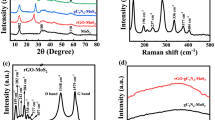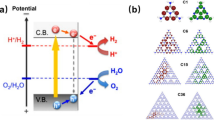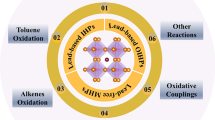Abstract
Coupling graphitic carbon nitride (CN) with carbonaceous materials is an effective strategy to improve photocatalytic performance, but the contributions of carbonaceous materials are not fully understood. Herein, a new type of carbon/CN (CCN) complex photocatalyst is synthesized with a 6-fold enhancement of H2 evolution rate compared to that of pristine CN. The role of carbon in photocatalytic H2 evolution reaction is systemically studied and it is experimentally and theoretically revealed that carbon mainly contributes to the improved capability of exciton dissociation and enhanced electric conductivity for charge transfer, leading to an increased population of photo-carriers for photocatalytic reactions. Interestingly, the enhanced light absorption originated from carbon barely generates charge carriers for H2 evolution activity. These new findings will inspire the rational design of carbon-based photocatalysts for efficient solar fuel production.

Similar content being viewed by others
References
Gust, D.; Moore, T. A.; Moore, A. L. Solar fuels via artificial photosynthesis. Acc. Chem. Res. 2009, 42, 1890–1898.
Tachibana, Y.; Vayssieres, L.; Durrant, J. R. Artificial photosynthesis for solar water-splitting. Nat. Photonics 2012, 6, 511–518.
Wang, X. C.; Maeda, K.; Thomas, A.; Takanabe, K.; **n, G.; Carlsson, J. M.; Domen, K.; Antonietti, M. A metal-free polymeric photocatalyst for hydrogen production from water under visible light. Nat. Mater. 2009, 8, 76–80.
Wang, Y.; Wang, X. C.; Antonietti, M. Polymeric graphitic carbon nitride as a heterogeneous organocatalyst: From photochemistry to multipurpose catalysis to sustainable chemistry. Angew. Chem., Int. Ed. 2011, 51, 68–89.
Ong, W. J.; Tan, L. L.; Ng, Y. H.; Yong, S. T.; Chai, S. P. Graphitic carbon nitride (g-C3N4)-based photocatalysts for artificial photosynthesis and environmental remediation: Are we a step closer to achieving sustainability. Chem. Rev. 2016, 116, 7159–7329.
Liao, G. F.; Gong, Y.; Zhang, L.; Gao, H. Y.; Yang, G. J.; Fang, B. Z. Semiconductor polymeric graphitic carbon nitride photocatalysts: The “holy grail” for the photocatalytic hydrogen evolution reaction under visible light. Energy Environ. Sci. 2019, 12, 2080–2147.
**ang, Q. J.; Yu, J. G; Jaroniec, M. Graphene-based semiconductor photocatalysts. Chem. Soc. Rev. 2012, 41, 782–796.
**ao, M.; Wang, Z. L.; Lyu, M. Q.; Luo, B.; Wang, S. C.; Liu, G.; Cheng, H. M.; Wang, L. Z. Hollow nanostructures for photocatalysis: Advantages and challenges. Adv. Mater. 2019, 31, 1801369.
Xu, Q. L.; Cheng, B.; Yu, J. G.; Liu, G. Making co-condensed amorphous carbon/g-C3N4 composites with improved visible-light photocatalytic H2-production performance using Pt as cocatalyst. Carbon 2017, 118, 241–249.
Li, K.; **e, X.; Zhang, W. D. Photocatalysts based on g-C3N4-encapsulating carbon spheres with high visible light activity for photocatalytic hydrogen evolution. Carbon 2016, 110, 356–366.
Baca, M.; Dworczak, M.; Aleksandrzak, M.; Mijowska, E.; Kaleńczuk, R. J.; Zielińska, B. Mesoporous carbon/graphitic carbon nitride spheres for photocatalytic H2 evolution under solar light irradiation. Int. J. Hydrogen Energy 2020, 45, 8618–8628.
Zhou, W. J.; Jia, J.; Lu, J.; Yang, L. J.; Hou, D. M.; Li, G. Q.; Chen, S. W. Recent developments of carbon-based electrocatalysts for hydrogen evolution reaction. Nano Energy 2016, 28, 29–43.
Schwab, M. G.; Fassbender, B.; Spiess, H. W.; Thomas, A.; Feng, X. L.; Müllen, K. Catalyst-free preparation of melamine-based microporous polymer networks through schiff base chemistry. J. Am. Chem. Soc. 2009, 131, 7216–7217.
Lin, X. Q.; Li, X. Z.; Li, F.; Fang, Y. Y.; Tian, M.; An, X. C.; Fu, Y.; **, J.; Ma, J. T. Precious-metal-free Co-Fe-Ox coupled nitrogen-enriched porous carbon nanosheets derived from schiff-base porous polymers as superior electrocatalysts for the oxygen evolution reaction. J. Mater. Chem. A 2016, 4, 6505–6512.
Wenderich, K.; Klaassen, A.; Siretanu, I.; Mugele, F.; Mul, G. Sorption-determined deposition of platinum on well-defined platelike WO3. Angew. Chem., Int. Ed. 2014, 53, 12476–12479.
Kresse, G.; Furthmüller, J. Efficiency of ab-initio total energy calculations for metals and semiconductors using a plane-wave basis set. Comput. Mater. Sci. 1996, 6, 15–50.
Kresse, G.; Furthmüller, J. Efficient iterative schemes for ab initio total-energy calculations using a plane-wave basis set. Phys. Rev. B 1996, 54, 11169–11186.
Perdew, J. P.; Burke, K.; Ernzerhof, M. Generalized gradient approximation made simple. Phys. Rev. Lett. 1996, 77, 3865–3868.
Grimme, S. Semiempirical GGA-type density functional constructed with a long-range dispersion correction. J. Comput. Chem. 2006, 27, 1787–1799.
Blöchl, P. E. Projector augmented-wave method. Phys. Rev. B 1994, 50, 17953–17979.
Monkhorst, H. J.; Pack, J. D. Special points for brillouin-zone integrations. Phys. Rev. B 1976, 13, 5188–5192.
Thomas, A.; Fischer, A.; Goettmann, F.; Antonietti, M.; Müller, J. O.; Schlögl, R.; Carlsson, J. M. Graphitic carbon nitride materials: Variation of structure and morphology and their use as metal-free catalysts. J. Mater. Chem. 2008, 18, 4893–4908.
Liu, J. T.; Nan, Y.; Chang, X. X.; Li, X. Z.; Fang, Y. Y.; Liu, Y.; Tang, Y.; Wang, X.; Li, R.; Ma, J. T. Hierarchical nitrogen-enriched porous carbon materials derived from Schiff-base networks supported FeCo2O4 nanoparticles for efficient water oxidation. Int. J. Hydrogen Energy 2017, 42, 10802–10812.
Yu, Y.; Yan, W.; Wang, X. F.; Li, P.; Gao, W. Y.; Zou, H. H.; Wu, S. M.; Ding, K. J. Surface engineering for extremely enhanced charge separation and photocatalytic hydrogen evolution on g-C3N4. Adv. Mater. 2018, 30, 1705060.
Che, W.; Cheng, W. R.; Yao, T.; Tang, F. M.; Liu, W.; Su, H.; Huang, Y. Y.; Liu, Q. H.; Liu, J. K.; Hu, F. C. et al. Fast photoelectron transfer in (Cring)-C3N4 plane heterostructural nanosheets for overall water splitting. J. Am. Chem. Soc. 2017, 139, 3021–3026.
Zhang, G. G.; Li, G. S.; Lan, Z. A.; Lin, L. H.; Savateev, A.; Heil, T.; Zafeiratos, S.; Wang, X. C.; Antonietti, M. Optimizing optical absorption, exciton dissociation, and charge transfer of a polymeric carbon nitride with ultrahigh solar hydrogen production activity. Angew. Chem., Int. Ed. 2017, 56, 13445–13449.
Niu, W. H.; Marcus, K.; Zhou, L.; Li, Z.; Shi, L.; Liang, K.; Yang, Y. Enhancing electron transfer and electrocatalytic activity on crystalline carbon-conjugated g-C3N4. ACS Catal. 2018, 8, 1926–1931.
Zhang, G.; Ji, Q. H.; Wu, Z.; Wang, G. C.; Liu, H. J.; Qu, J. H.; Li, J. H. Facile “spot-heating” synthesis of carbon dots/carbon nitride for solar hydrogen evolution synchronously with contaminant decomposition. Adv. Funct. Mater. 2018, 28, 1706462.
Ma, T. Y.; Dai, S.; Jaroniec, M.; Qiao, S. Z. Graphitic carbon nitride nanosheet-carbon nanotube three-dimensional porous composites as high-performance oxygen evolution electrocatalysts. Angew. Chem., Int. Ed. 2014, 53, 7281–7285.
Zheng, Y.; Jiao, Y.; Zhu, Y. H.; Li, L. H.; Han, Y.; Chen, Y.; Du, A. J.; Jaroniec, M.; Qiao, S. Z. Hydrogen evolution by a metal-free electrocatalyst. Nat. Commun. 2014, 5, 3783.
Kang, Y. Y.; Yang, Y. Q.; Yin, L. C.; Kang, X. D.; Wang, L. Z.; Liu, G.; Cheng, H. M. Selective breaking of hydrogen bonds of layered carbon nitride for visible light photocatalysis. Adv. Mater. 2016, 28, 6471–6477.
Fu, J. W.; Yu, J. G.; Jiang, C. J.; Cheng, B. g-C3N4-based heterostructured photocatalysts. Adv. Energy Mater. 2018, 8, 1701503.
Wang, H.; Sun, X. S.; Li, D. D.; Zhang, X. D.; Chen, S. C.; Shao, W.; Tian, Y. P.; **e, Y. Boosting hot-electron generation: Exciton dissociation at the order-disorder interfaces in polymeric photocatalysts. J. Am. Chem. Soc. 2017, 139, 2468–2473.
Tan, H. L.; Wen, X. M.; Amal, R.; Ng, Y. H. BiVO4 {010} and {110} relative exposure extent: Governing factor of surface charge population and photocatalytic activity. J. Phys. Chem. Lett. 2016, 7, 1400–1405.
Wu, H.; Zheng, Z. K.; Toe, C. Y.; Wen, X. M.; Hart, J. N.; Amal, R.; Ng, Y. H. A pulse electrodeposited amorphous tunnel layer stabilises Cu2O for efficient photoelectrochemical water splitting under visible-light irradiation. J. Mater. Chem. A 2020, 8, 5638–5646.
Samsudin, M. F. R.; Ullah, H.; Bashiri, R.; Mohamed, N. M.; Sufian, S.; Ng, Y. H. Experimental and DFT insights on microflower g-C3N4/BiVO4 photocatalyst for enhanced photoelectrochemical hydrogen generation from lake water. ACS Sustain. Chem. Eng. 2020, 8, 9393–9403.
Sun, J. H.; Zhang, J. S.; Zhang, M. W.; Antonietti, M.; Fu, X. Z.; Wang, X. C. Bioinspired hollow semiconductor nanospheres as photosynthetic nanoparticles. Nat. Commun. 2012, 3, 1139.
Liu, G. G.; Zhao, G. X.; Zhou, W.; Liu, Y. Y.; Pang, H.; Zhang, H. B.; Hao, D.; Meng, X. G.; Li, P.; Kako, T. et al. In situ bond modulation of graphitic carbon nitride to construct p-n homojunctions for enhanced photocatalytic hydrogen production. Adv. Funct. Mater. 2016, 26, 6822–6829.
Zhang, Y. J.; Mori, T.; Niu, L.; Ye, J. H. Non-covalent do** of graphitic carbon nitride polymer with graphene: Controlled electronic structure and enhanced optoelectronic conversion. Energy Environ. Sci. 2011, 4, 4517–4521.
Meek, G. A.; Baczewski, A. D.; Little, D. J.; Levine, B. G. Polaronic relaxation by three-electron bond formation in graphitic carbon nitrides. J. Phys. Chem. C 2014, 118, 4023–4032.
Acknowledgement
The financial support from Australian Research Council (ARC) through the Discovery and Laureate Fellowship programs is greatly acknowledged. The authors would like to express their appreciations for the support from the Australian National Fabrication Facility-Queensland Node (ANFF-Q) and the Centre for Microscopy and Microanalysis (CMM) from the University of Queensland. The support from the Centre of Advanced Imaging is also highly appreciated. M. X. would like to express her gratitude for the financial support from the Australian Government through the Research Training Program Scholarship.
Author information
Authors and Affiliations
Corresponding authors
Electronic Supplementary Material
Rights and permissions
About this article
Cite this article
**ao, M., Jiao, Y., Luo, B. et al. Understanding the roles of carbon in carbon/g-C3N4 based photocatalysts for H2 evolution. Nano Res. 16, 4539–4545 (2023). https://doi.org/10.1007/s12274-021-3897-7
Received:
Revised:
Accepted:
Published:
Issue Date:
DOI: https://doi.org/10.1007/s12274-021-3897-7




